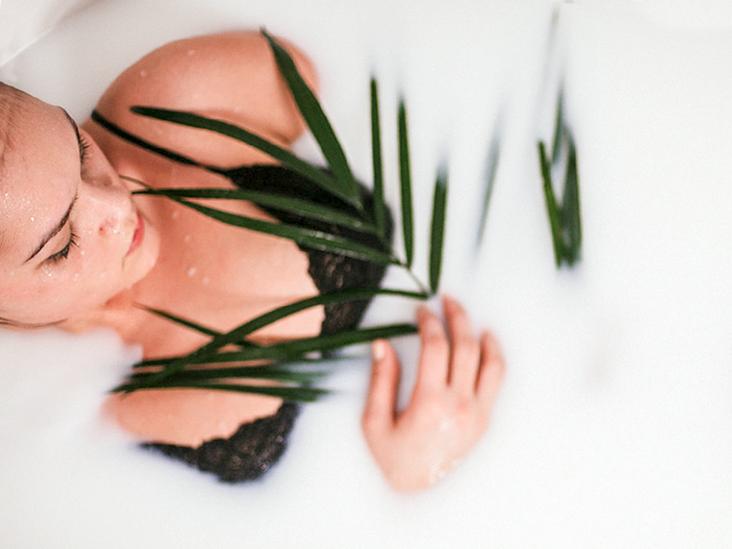Casey Gallagher, MD, is board-certified in dermatology and works as a practicing dermatologist and clinical professor.
Learn about our Medical Review BoardTable of ContentsView AllTable of ContentsThe idea of taking a long, hot soak in a milk bath may seem like a strange concept to the uninitiated, but people have been enjoying the benefits of milk baths for centuries.
History tells us that the ancient Romans regularly used milk baths. In the United States, bathing your face in buttermilk was popular around the turn of the century. According to legend, Cleopatra obtained her famous complexion by bathing in milk and honey.
Milk baths are making a comeback today, with many celebrities sharing how milk baths are part of their beauty regimen.
No good scientific studies on the effects of milk baths have been conducted. There is anecdotal evidence, though, suggesting that milk baths may have skincare benefits.
Milk can make your skin feel softer and smoother because fats in the milk cling to the skin. You'll notice a silky, but not oily, feeling over your skin.
Bathing in milk can also give light, gentle exfoliation. Milk, especially soured milk like buttermilk, contains lactic acid. Lactic acid is an alpha hydroxy acid commonly used in skin care products and cosmeceuticals.
Lactic acid helps dissolve the intercellular "glue" that holds dead skin cells together. These cells slough off more effectively, making room on the skin's surface for smoother, brighter cells.
Be aware though, that bathing in milk won't have the same potency of lactic acid lotions or moisturizing creams. These products are designed and formulated to give a specific result and contain a much higher percentage of lactic acid than does milk.
But milk baths can make your skin feel less dry, at least temporarily. This is thanks to the gentle exfoliation coupled with milk's skin smoothing fats and proteins.

Of course, we can't forget the psychological effects milk baths give. Milk baths, when blended with fragrance or herbs, smell good. They feel opulent and luxurious. Soaking in a milk bath is a nice way to relax and unwind.
Best Face Washes for Dry SkinWhat can a milk bath not do for your skin? Lovely as they are, milk baths are cosmetic or beauty remedies; they will not treat any skin condition.
Milk has been used as a folk remedy for things like sunburn, skin irritations, hyperpigmentation, eczema, and psoriasis. There's no conclusive evidence that milk baths help improve any of these skin problems.
The effect topical milk products have on eczema has been studied. But the research is conflicting. And most studies have been done with human breast milk, which most people will not be using in their daily milk baths.
If you need help treating any skin problem, don't hop into the tub. Give your physician a call instead.
Emollient Moisturizers Can Help Your Dry SkinYou can use real milk, (the stuff you drink) to make a milk bath. There are many different types of milk at your disposal, and each will give the milk bath a slightly different look and feel.
A bath in store-bought milk would be costly (not to mention sticky), so dilute these milks into your warm bathwater:
If you are lactose-intolerant, and drinking milk upsets your stomach, you generally can take milk baths safely and without any problem. You may not be able to digest milk, but in most cases, it won't be bothersome to your skin.
This is not the case for those with a true milk allergy. Do not take a milk bath if you are allergic to milk. Coming in contact with milk is likely to cause a reaction, like itching, rash, hives. Soaking in a tub of it is not a good idea.
Milk baths are super easy to make. It's as simple as pouring your chosen milk into warm bath water and soaking. However, unless you want thin, thready bubbles in your bath, add the milk after you've finished filling the tub. Measurements don't need to be exact:
If you're feeling creative, you also can add a handful of finely ground oats, lavender buds or rose petals (fresh or dried), 1/2 cup Epsom salts or sea salt, a few drops of skin-safe essential oils, or a tablespoon of honey.
If you prefer a prepackaged milk bath, you've many choices. The prepackaged milk baths available today run the gamut from handcrafted products made with natural ingredients to foaming products similar to bubble bath.
To ensure you're getting what you think you're getting from a product, take a quick peek at the ingredient label. Milk or milk protein needn't be the first ingredient, but it should be listed rather high on the list.
The Best Body Washes for Dry SkinIn general, milk baths are very gentle and safe. Most people can use them without any problem. Milk baths are nice cosmetic treatments that make your skin feel soft and smooth. But don't expect them to heal any skin problem.
Was this page helpful?Thanks for your feedback!Sign up for our Health Tip of the Day newsletter, and receive daily tips that will help you live your healthiest life.
You're in!Thank you, {{form.email}}, for signing up.
There was an error. Please try again.